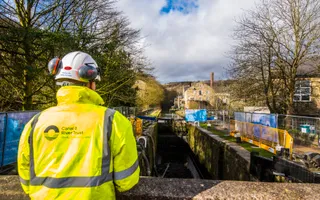Stay safe around bridges by checking for oncoming boats and being aware of low headroom.
How to navigate bridges
Remember that many bridges have low headroom. Weather conditions upstream have an effect on river water levels – good clearance today might disappear tomorrow if water levels rise.
Bridges can be narrow, too, which means river water tends to speed up as you get nearer. This can draw your boat towards the bridge, so stay alert. Boats travelling downstream on rivers have the right of way at bridges and narrow stretches.
Safety tips for boating through bridges
- keep everyone off the roof and within the profile of the boat
- if navigating a swing or lift bridge, don't try to take your boat through until the bridge is fully open and secure (they can stick at the wrong moment
- take care with clearance under lift and fixed bridges and stay in the centre of the channel
- watch out for slippery surfaces when you're pushing swing bridges
- use a strong, fit crew to operate moving bridges
Swing and lift bridges
Well before you reach the bridge, let your crew off the boat with the windlass or key.
If it's a traffic bridge, check that the road's clear and close the warning barriers if there are any. Don't forget to open the barriers once the bridge is back in place.
Manual swing bridges
Let your crew off well before the bridge. With plenty of room, it's easier to get the boat lined up correctly. Unhook the retaining chain and give the bridge a good but controlled shove. You might need to slow the swing down to stop the bridge from bouncing back across the canal when it hits the buffer stop. When the boat's through, push the bridge firmly into place and put the retaining chain or lock back on.
Manual lift bridges
Pull the chain hanging from the balance arm. When the bridge is open unless it's obvious that there's a mechanism to stop the bridge from lowering by itself, sit an adult on the arm to keep it raised until the boat's clear. Gently lower the bridge by the chain, taking care not to let it drop.
Mechanised bridges
Mechanised bridges are either opened using the windlass or are powered and need a navigation authority facilities key. Always follow the instructions.
With some swing and lift bridges, you can't move the traffic barriers until you've unlocked the control box. And you can't move the barriers back again until the bridge is back in its original position.
Windlass-operated bridges need to be unlocked first, but you must make sure you lock them again before cars are allowed back over.
Some modern bridges use wedges to stop them from bouncing when cars drive over. You should find instructions at the bridge on how to release them. Always make sure they're back in place, though, or traffic will damage the bridge mechanism.





